#LancashireDay is celebrated on 27th November. On this day in 1295 the first elected representatives from Lancashire were called to Westminster by King Edward I to attend what later became known as “The Model Parliament”. We present our portrait of the county and a Map of Lancashire.
Lancashire is a maritime county in the north-west of England. Lancashire has a unique industrial heritage. Away from the industrial and urban areas, the county contains scenery of much beauty and jarring contrasts.
The land that would become Lancashire had been part of the Kingdom of Northumbria. The River Mersey, and further east, the River Tame, was considered the border with Mercia. The Honour of Lancaster was established after the Norman conquest after a wide band of territory, including the lands between the River Ribble and the River Mersey, was granted by William the Conqueror to Roger the Poitevin. In the early 1090s, Lonsdale, Cartmel and Furness were added to Roger’s estates. From 1164 until 1189 the Honour of Lancaster was held by the crown and its accounts are recorded in the Pipe rolls. In 1182 Lancashire was first recorded as a separate shire. The county was at the heart of the Industrial Revolution: its mines, foundries and mills supplying the world. The county retains a strong manufacturing base but its economy is increasingly based around service-industries, retail, leisure and tourism.
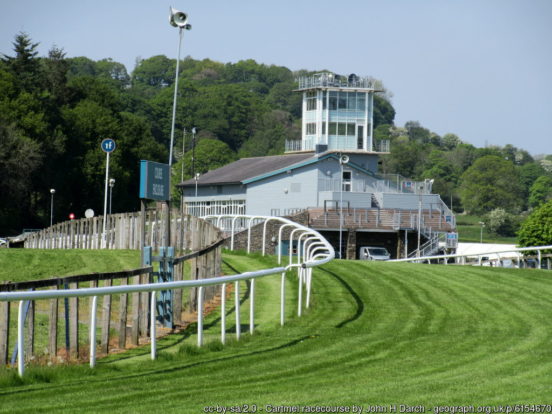
The main body of Lancashire runs up the English west coast from the Mersey to Morecambe Bay. In south-east Lancashire, around the rivers Mersey, Tame and Irwell are the major towns and cities of Manchester, Salford, Eccles, Stretford and Ashton-under-Lyne. West along the Mersey are Warrington and Widnes and then, on the Mersey estuary, the mighty port of Liverpool. The West Lancashire Coastal Plain stretches from the Mersey estuary up to the Ribble, including the famous resorts of Southport and Formby. To its east is the heart of the South Lancashire Coal Field with its many former mining towns including Wigan, St Helens and Leigh. Between Manchester and the West Pennines/Rossendale lie many of Lancashire’s great industrial towns including Bolton, Bury, Rochdale and Oldham. North of the West Pennines, in the valleys of the Calder and Ribble, are the famous industrial towns of Blackburn, Burnley, Nelson and Colne, with Pendle Hill and Clitheroe to their north. The Fylde coastal plain stretches from Preston on the Ribble up to Lancaster on the Lune. The Fylde’s coast is a string of holiday resorts centred on the best known of them all: Blackpool. Lonsdale stretches from Lancaster up beyond Lancashire’s main body into Westmorland. Across Morecambe Bay, separated from the county’s main body by Westmorland, is Lancashire North of the Sands, with its stunning Lakeland scenery.
Lancashire North of the Sands lies to the north and west of the Kent estuary, where the southernmost spur of Westmorland steps between and divides the two parts of Lancashire. The southern part of Lancashire North of the Sands comprises the Furness Peninsula and the Cartmel Peninsula, primarily agricultural areas. The northern part, known as High Furness, extends inland into the Lake District (a UNESCO World Heritage Site).
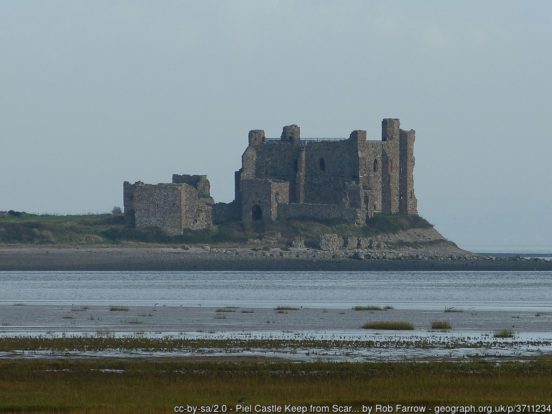
The Furness peninsula projects into the Irish Sea between the Leven and Duddon estuaries. The south-east coast of the peninsula faces on to Morecambe Bay. Its main town, Barrow-in-Furness, is sheltered from the Irish Sea by Walney Island, a 14-mile-long island connected to the mainland by the bascule-type Jubilee Bridge. Barrow grew from a small fishing village to an industrial and port town. It has the largest working shipyard in Britain. Piel Island, in the Walney Channel, is a haven for seabirds and the site of Piel Castle, built by the monks of Furness Abbey to protect the harbour.

The ruins of Furness Abbey (EH) lie between Barrow-in-Furness and the small town of Dalton-in-Furness. The abbey dates back to 1123 and was once one of the most powerful Cistercian monasteries in the country. Dalton Castle (NT) is a 14th-century peel tower built by the monks to protect the town. Ulverston is a market town close to the Leven estuary to which it was connected by the Ulverston Canal, once vital to the town’s economy. Stan Laurel was born here in 1890. A statue of Laurel and Hardy stands outside Coronation Hall.
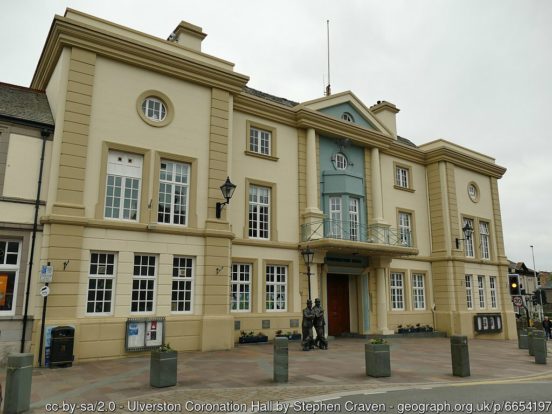
The Cartmel Peninsula juts into Morecambe Bay between the estuaries of the rivers Kent and Leven. Grange-over-Sands is a Victorian seaside resort. In the Middle Ages the peninsula was controlled by the monks of Cartmel Priory. The Priory’s imposing church now serves as the parish church at Cartmel. Holker Hall, dating to the 16th century, was described by Pevsner as “the grandest [building] of its date in Lancashire …by the best architects then living in the county”. The delightful Cartmel racecourse is nearby.

High Furness is dominated by the high peaks of the Furness Fells. Lancashire’s border with Cumberland follows the River Duddon up to the Three Shire Stone at the top of the Wrynose Pass, the point where Cumberland, Lancashire and Westmorland meet. Wordsworth wrote in soaring praise of the beauty and quiet of the Duddon valley.
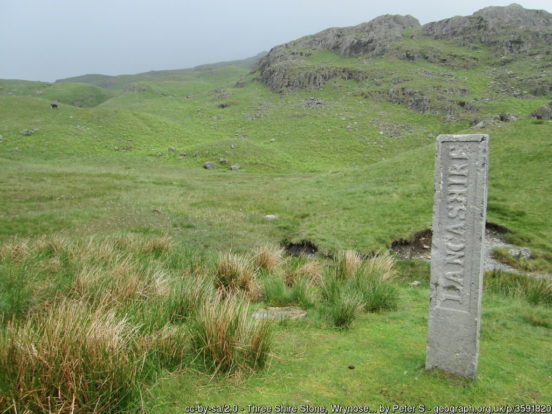
From the Three Shire Stone, the Lancashire – Westmorland border follows the Brathay until it joins the River Rothay as it flows into Windermere. The border runs down the western shore of Windermere. Wray Castle (NT) is a Victorian neo-gothic building on the northern end of this shore. The southern end of the eastern shore of Windermere is also in Lancashire, as far north as Black Beck. Fell Foot Park (NT), formerly the grounds of a Victorian house, spreads out beside the lake near Staveley-in-Cartmel. Stott Park Bobbin Mill (EH) is a 19th-century bobbin mill and now a working museum near Newby Bridge. From Black Beck, the border briefly crosses countryside and then is formed by the River Winster.
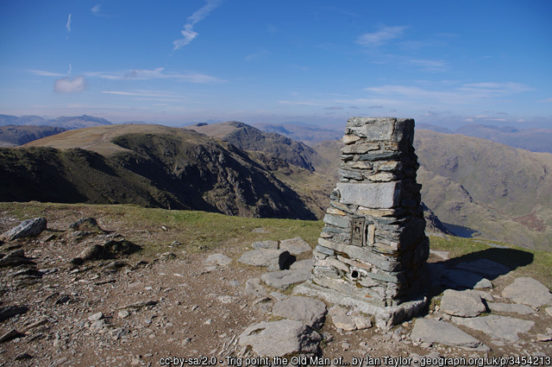
Coniston Water, one of the finest of all the Lakes, lies at the heart of High Furness. West of the lake are the Coniston Fells. Here lies the county top, The Old Man of Coniston (2,633 feet). The Victorian artist and philosopher John Ruskin owned Brantwood House on the eastern shore of the lake, and lived in it from 1872 until his death in 1900. The house is a museum dedicated to him. Ruskin is buried in the churchyard in Coniston. The lake is famous for the several world water speed records set on it by Sir Malcolm Campbell and his son Donald Campbell. It was the site of Donald Campbell’s fatal accident in 1967. The lake and its surroundings can be enjoyed in Victorian luxury on the Steam Yacht Gondola (NT).
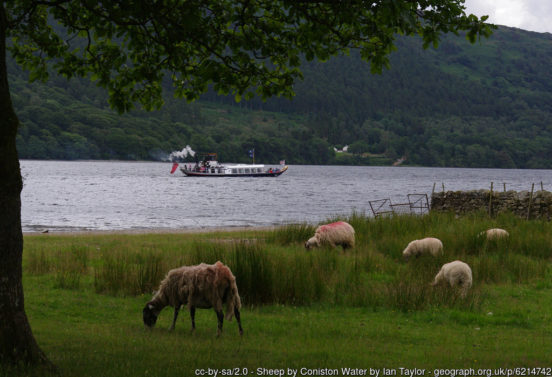
Grizedale Forest, between Coniston Water and Windermere, spreads over the hills around the villages of Grizedale and Satterthwaite. To its north is Esthwaite Water, known for its excellent fishing. The 17th century Hill Top Farm (NT) in the village of Near Sawrey was the home of famous children’s author and illustrator Beatrix Potter. North of Esthwaite Water is Hawkshead, a village with a timeless atmosphere, consisting of a characterful warren of alleys, overhanging gables and a series of mediæval squares. Wordsworth attended Hawkshead Grammar School. The town is eloquently described in his poem The Prelude. The Beatrix Potter Gallery (NT) presents original illustrations by Beatrix Potter.

The village of Silverdale stands on Morecambe Bay in the far north-west of the main body of Lancashire. Inland is the wetland nature reserve of Leighton Moss, famous for its resident bitterns. Around the moss are low, heavily wooded hills of Carboniferous Limestone, including Warton Crag (535 feet). East of the hills the land is flatter and is crossed by the ancient north–south aligned transport route, now with the motorway and rail networks. East of this is Lonsdale, the River Lune crossing into Lancashire south of Kirby Lonsdale in Westmorland. In the far north-east of the main body of Lancashire lies Leck Fell, on the edge of the Pennines, and, among the fells, the County Stone where Lancashire meets Westmorland and Yorkshire.
South of Silverdale, on the River Keer, lies the railway town of Carnforth. Carnforth railway station was used as the set for David Lean’s 1945 film Brief Encounter. The villages of Bolton-le-Sands and Hest Bank, alongside Morecambe Bay, also grew with the railways.
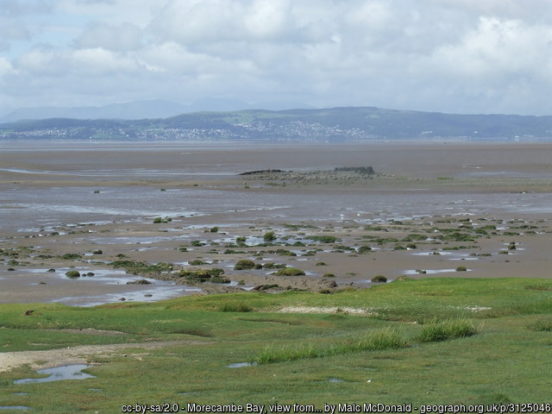
Lonsdale broadens as the Lune flows south-west to the city of Lancaster. The landscape in Lonsdale is mainly one of pastoral agriculture. The Pennines, including the Tatham Fells and Lythe Fell, stretch across from Yorkshire to within a few miles of Lancaster. Lancaster’s name was first recorded in the Domesday Book in 1086 as Loncastre, where “Lon” refers to the River Lune, and “castre”, from the Old English cæster, refers to the Roman fort which stood on the hill on which the mediæval Lancaster Castle was later built. Lancaster Priory, now a parish church, was the church of the Benedictine priory of St Mary, founded in 1094. The Ashton Memorial, built between 1907-1909 by industrialist Lord Ashton in memory of his wife Jessy, dominates the skyline.

The Lune becomes tidal at the weir in the centre of Lancaster. It flows thence east then sweeps south and enters Morecambe Bay at Plover Scar. The famous Lancashire seaside resort of Morecambe lies on the peninsula between the Lune estuary and Morecambe Bay. The town’s origins lie in the building of a harbour and connecting railway close to the fishing village of Poulton-le-Sands in the 1840s. The resort which grew around the harbour came to be known as “Morecambe”. The town expanded to absorb Poulton and the villages of Bare and Torrisholme. The comedian Eric Morecambe was born in the town, from which he later took his stage name, in 1926.

The ferry port of Heysham is south of Morecambe. The ancient St Patrick’s Chapel stands in ruins on the cliff-edge. The chapel contain a unique Anglo-Saxon arch and several grave-holes, thought to date from the 11th century, hewn out of solid rock into the shapes of the bodies they were to receive. St Peter’s Church contains a Norse hogback stone of unknown purpose or meaning. A pre-Roman labyrinth is carved in the rocks of the foreshore. The Barrows are the only sea-cliffs in Lancashire. The name, and the discovery of Stone Age artefacts, suggest this may have been an ancient burial ground. The rest of the peninsula is rural. Middleton was the site of Middleton Tower Holiday Camp from 1939 to 1994. At the tip of the peninsula is Sunderland Point. The village of Sunderland is the only community in Great Britain to be on the mainland and yet dependent upon tidal acces.
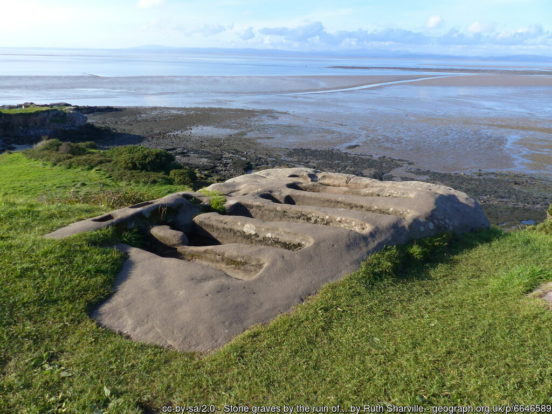
To the south of Lancaster, as far as the River Ribble, stretches the Fylde (or Amounderness) coastal plain. On its east are the foothills of the Pennines. It is a flat, alluvial plain, parts of which were once dug for peat. Away from its towns, the Fylde is predominantly improved pasture, with isolated arable fields. The ancient market town of Garstang stands on the Wyre near the eastern edge of the plain. The ruins of 15th-century Greenhalgh Castle stand nearby. The River Wyre meanders across the Fylde from Garstang, westwards towards Poulton and then northwards to the sea at Fleetwood. The area north and east of the tidal Wyre, known as Over Wyre, is the more rural side of the river. The west coast is almost entirely urban.
Fleetwood, at the mouth of the Wyre, was developed in the 1830s as a seaport and railway spur. It is world-famous as the home of Fishermen’s Friends. The resort of Cleveleys lies on the coast whilst its near neighbour Thornton lies east on the Wyre estuary. South of Cleveleys is the famous seaside town of Blackpool. Blackpool was a coastal hamlet into the 19th century. A railway was built in the 1840s connecting it to the industrialised regions of northern England. By 1881 Blackpool was a booming resort with a promenade complete with piers, fortune-tellers, public houses, tram and donkey rides, fish-and-chip shops and theatres. Millions still visit every year to enjoy its beaches, its atmosphere and its many attractions, including the Blackpool Tower, Blackpool Illuminations, the Pleasure Beach, and the Winter Gardens. The Blackpool Tramway, opened in 1885, runs from Blackpool to Fleetwood. Blackpool Heritage Trams runs a ‘heritage service’ with restored trams from the 1930s onwards.
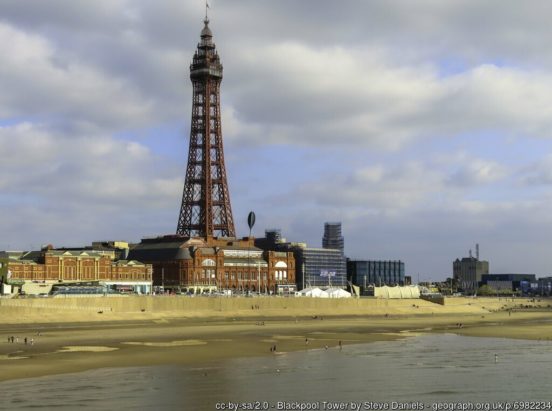
South of Blackpool is the relative tranquility of St Anne’s-on-the-Sea, which retains much of its original character of a traditional Victorian seaside resort with up-market hotels, a sandy beach, donkeys, a small pier and ice cream stalls. Its near neighbour Lytham stands at the mouth of the River Ribble. The Green, running between the shore and the main coastal road, is a popular spot. Lytham Windmill, built around 1805, stands on The Green. Between the towns is the famous Royal Lytham & St Annes Golf Club. The market town of Poulton-le-Fylde stands a little inland from the busy coastline.
Kirkham, in the south of the Fylde, owes its existence to Carr Hill upon which it was built and which was the location of a Roman fort. The city of Preston lies at the very south end of the Fylde, on the north bank of the Ribble. Textiles were produced from the mid-13th century. Sir Richard Arkwright, inventor of the spinning frame, was born here. The Roman Catholic Church of St Walburge boasts the tallest church spire in England that is not on a cathedral (308 ft). The Preston Bypass, opened in 1958, was the United Kingdom’s first motorway.
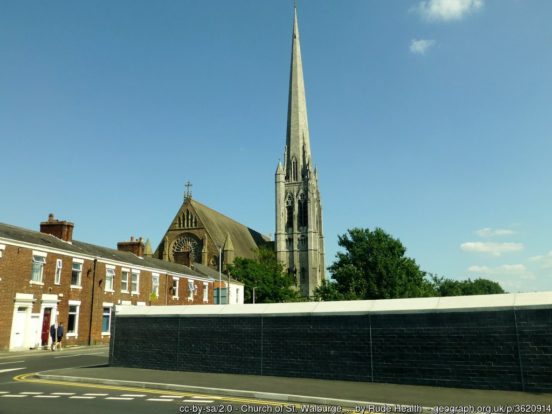
East of the Fylde the land rises towards the Pennines. East of Garstang are the Bleasdale Moors and Little Bowland, the only part of the ancient Forest of Bowland in Lancashire. To the south, the town of Longridge lies at the western end of Longridge Fell. To the north-west is Clitheroe near the border with Yorkshire. Clitheroe Castle stands on top of a 115-foot outcrop of limestone and is one of the oldest buildings in Lancashire. South-east of the town is Pendle Hill, its gaunt yet beautiful outline visible for huge distances. During the reign of James 1, Pendle was the backdrop to the strange saga of the Lancashire Witches. In 1652 George Fox experienced amazing visions as he ascended Pendle. They led him to found the Quaker movement.
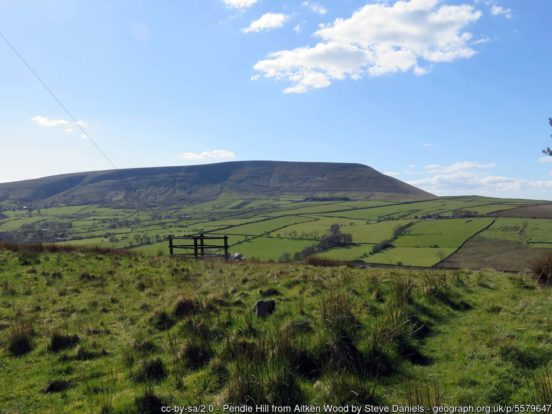
The Lancashire Valleys broadly consist of the wide vale of the rivers Ribble and Calder and their tributaries, between the natural backdrops of Pendle Hill to the north and the West Pennine Moors to the south. This area has a strong urban character. Colne stands close to the Yorkshire border with beautiful countryside all around it. The nearby hamlet of Wycoller has a famous two-arched packhorse bridge, as well as the Clapper bridge and Clam bridge, claimed to be of great antiquity. An Iron Age hillfort called Castercliff is on a hill to the east of the former mill town of Nelson.
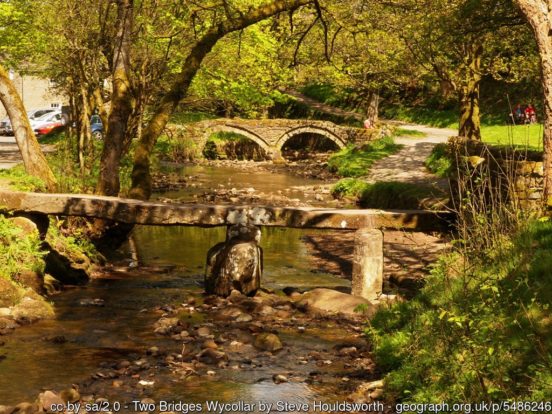
Burnley was one of Lancashire’s most prominent mill towns: at its peak it was one of the world’s largest producers of cotton cloth. It has retained a strong manufacturing sector. The Burnley Embankment, known locally as the Straight Mile, is an embankment carrying the Leeds and Liverpool Canal across the Calder and Brun valleys. The embankment is 1,256 yards long and the canal runs up to 60 feet above the valley floor. The structure was chosen as one of the original Seven Wonders of the Waterways in 1946. Padiham lies three miles west of Burnley. Nearby is Gawthorpe Hall (NT), an Elizabethan country house on the banks of the River Calder.
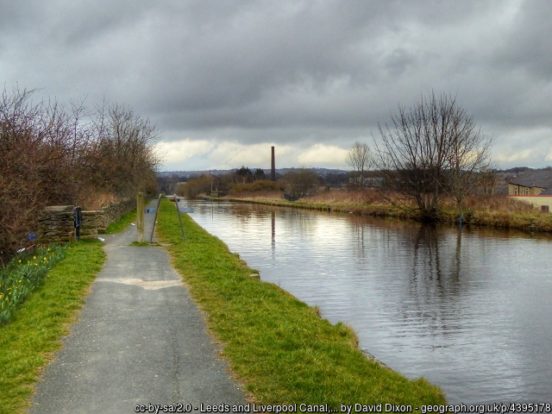
Accrington is famed for manufacturing the hardest building bricks in the world, “The Accrington NORI”, used in the Empire State Building and the Blackpool Tower. The Haworth Art Gallery holds Europe’s largest collection of Tiffany glass. Oswaldtwistle has a rich industrial heritage, being home to James Hargreaves, inventor of the spinning jenny.
Blackburn is located where a Roman military road crossed the river Blakewater. The road linked the Roman forts at Bremetennacum Veteranorum (Ribchester) with Mamucium (Manchester). Textiles were produced in the town from the 13th century, when wool was woven in people’s houses. Blackburn Cathedral was formerly St Mary’s Parish Church. Between the 1930s and 1960s an enlarged cathedral was built using the existing building as the nave. Blackburn’s statue of Queen Victoria overlooks the Cathedral Square. Darwen lies on the River Darwen, south of Blackburn, in the foothills of the West Pennine Moors. To the west of Blackburn is Hoghton Tower, a fortified manor house dating from about 1560. It takes its name from the de Hoghton family, its historical owners since at least the 12th century.
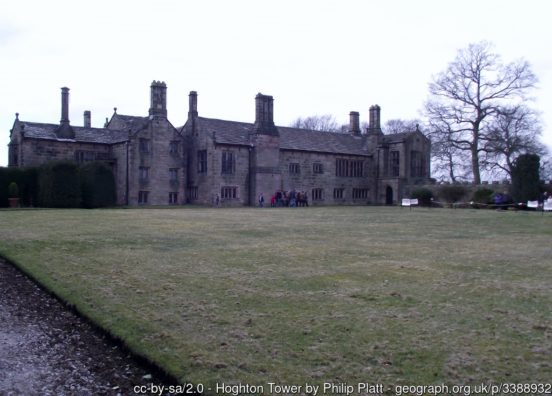
Ribchester lies on the Ribble six miles north-west of Blackburn. This is a significant Roman site, being the location of the cavalry fort called Bremetennacum. A major Roman road ran through here. St Wilfrid’s Church, believed to have been founded by St Wilfrid in the 8th century, stands on what was the centre of the Roman fort.
Chorley’s wealth came principally from the cotton industry. Remnants of the industrial past include the Victoria Mill chimney. Astley Hall dates from the 16th century. The interior is notable for the staggering mid-17th-century plasterwork of its ceilings. The landscaped grounds form Astley Park. Chorley is known as the birthplace of the Chorley cake.
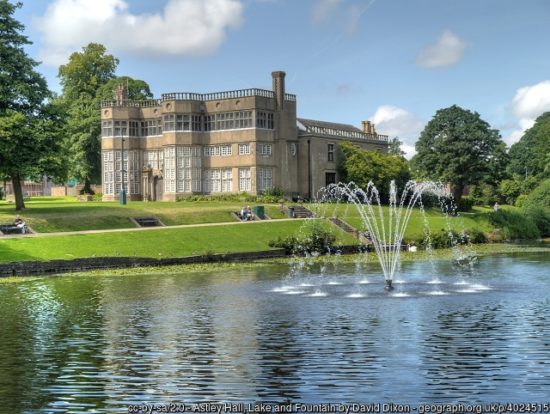
The West Pennine Moors, separated from the main Pennine range by the Irwell Valley, cover 90 square miles of moorland and reservoirs. The moors provide a dramatic backdrop to the Lancashire Valleys’ towns to their north and west; and to the great industrial towns of Bolton and Bury to the south. The highest point is at Winter Hill (1,486 feet) with it transmitting station. The Pike Tower, on top of Rivington Pike, was built by John Andrews of Rivington Hall in 1733. A famous local landmark, with spectacular views over the West Lancashire Coastal Plain to the Blackpool Tower and far beyond. Below the Pike Tower, the soap magnate Lord Leverhulme built Rivington Terraced Gardens with the help of Thomas Mawson between 1905 and 1925. It remains a magical place of hidden paths, caves, structures and lakes.
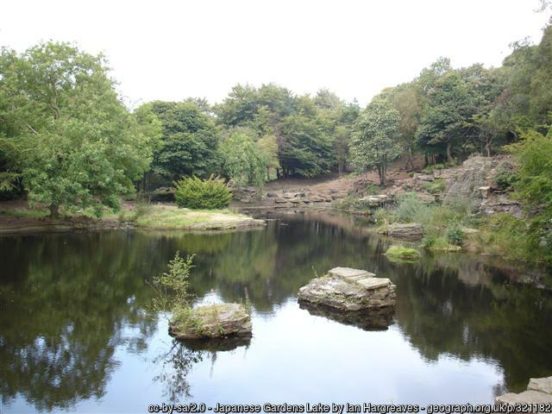
The Pennines between the Irwell and the Yorkshire border are known as the Rossendale Hills. Rossendale is the steep sided valley of the River Irwell and its tributaries. During the Industrial Revolution, towns grew up at the river crossing points between Rawtenstall and Bacup and today form a contiguous urban area. Textile mills and chimneys and gritstone terraced houses are the dominant buildings. To the north are the Lancashire Valleys’ towns of Burnley, Nelson and Colne. To the south are Rochdale and Littleborough.
The border town of Todmorden stands in the upper Calder Valley, east of Rossendale. The border with Yorkshire is marked by the original course of the River Calder and its tributary, the Walsden Water. Todmorden’s 1876 neo-classical town hall was deliberately built above the Walsden Water. On the left-hand side of the front pediment is a sculpture representing Lancashire (cotton spinning and weaving), on the right-hand side is one representing Yorkshire (wool manufacturing, engineering and agriculture). The border also runs through the town’s cricket pitch, while most of the field is in Yorkshire, the pavilion is in Lancashire.
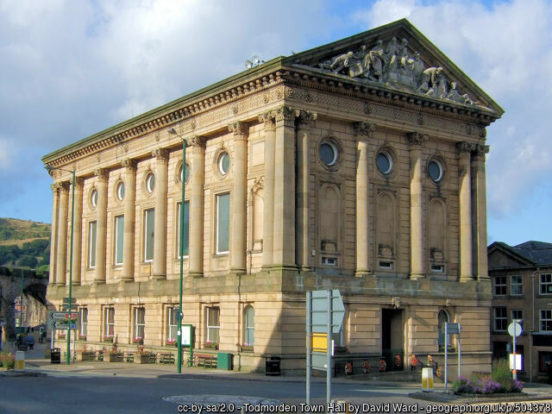
Along the foothills of the West Pennines and the Rossendale hills, stretching down towards the Mersey valley, lie many of Lancashire’s great industrial towns. The river valleys, upland hinterland and proximity of urban development all contribute to giving the area a distinct Pennine fringe character.
Horwich emerged in the Middle Ages as a hunting chase. During the Industrial Revolution, the textile industry and the Horwich Works became major employers. Urban regeneration has been led by out of town developments, particularly at Middlebrook which is the base of Bolton Wanderers football club.
Bolton was one of the most productive centres of cotton spinning in the world. Traditional industries have largely been replaced by service-based activities. Smithills Hall is a Grade I listed manor house on the moors above Bolton. Its oldest parts, including the great hall, date from the 15th century. Hall i’ th’ Wood is an early 16th-century manor house. One part was let to Samuel Crompton during the 18th century, where he designed and built the first spinning mule.
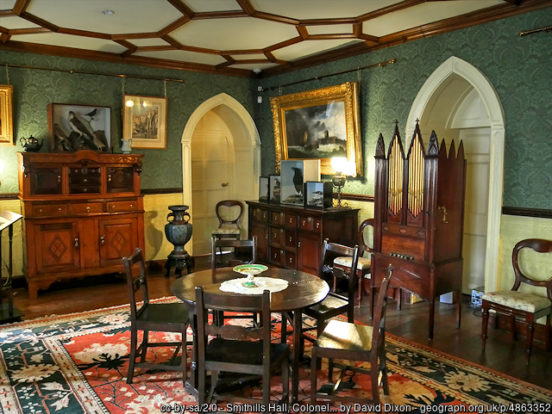
Ramsbottom sits on the River Irwell at the bottom of Rossendale. The town’s Victorian architecture, its industrial heritage and the beautiful Pennine landscape contribute to heritage tourism in the town. The East Lancashire Railway is a heritage railway which runs through the town, on its line between Heywood and Rawtenstall. Above the town, on Holcombe Hill, stands the Peel Tower – a memorial to Sir Robert Peel, born in nearby Bury.
Bury emerged during the Industrial Revolution as a mill town centred on textile manufacture. The town centre is famous for the traditional market, with its “world famous” black pudding stalls. Castlesteads is an Iron Age promontory fort, situated on the east bank of the River Irwell on a natural promontory. Bury Art Museum holds the Wrigley collection of paintings, which includes works by J. M. W. Turner, Edwin Henry Landseer, John Constable and Peter De Wint. The Fusilier Museum is the home of collections of the 20th Lancashire Fusiliers and the Royal Regiment of Fusiliers. Radcliffe lies 3 miles further down the Irwell valley. Radcliffe Tower is all that remains of an early 15th-century stone-built manor house. The nearby tithe barn was probably built between 1600 and 1720. The former mill town of Whitefield is contiguous with Radcliffe.
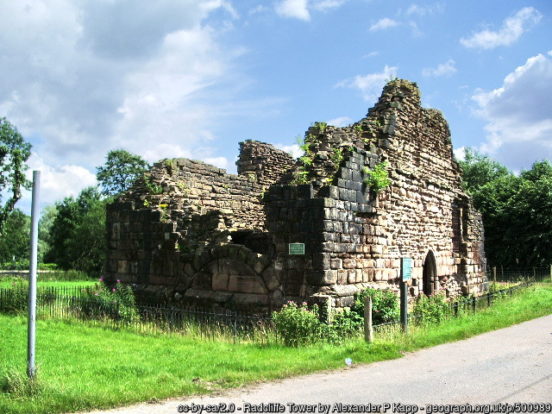
Prestwich, further south on the Irwell, is now a suburban town. The oldest part of Prestwich, around Bury New Road, is known as Prestwich Village. Bury New Road roughly follows the line of the Roman road connecting Mamucium (Manchester) and Bremetennacum (Ribchester). It is possible that a Roman fort was built at “Castle Hill”.
The former mill town of Heywood lies east of Bury, on the River Roch. The Cheesden Valley, to its north, became a centre of cotton production dependent on running water. Many of the former mills, lodges and a solitary chimney, along with other industrial workings such as weirs and dykes, are still evident today. To its south is Middleton, formerly a centre of silk production. The Church of St Leonard dates from 1412. The Flodden Window is thought to be the oldest war memorial in the United Kingdom. It memorialises the names of the Middleton archers who fought at Flodden Field in 1513. Tonge Hall is an Elizabethan manor house.
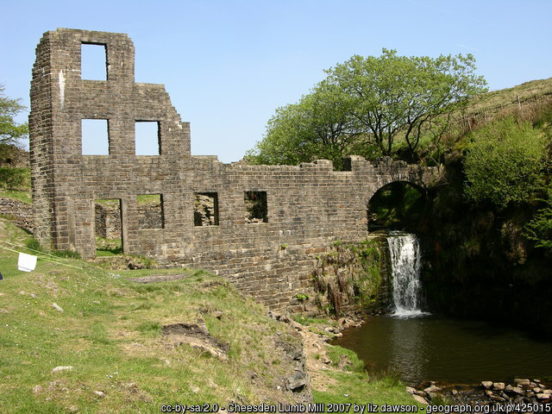
Rochdale lies among the foothills of the Rossendale Hills in the valley of the River Roch. Blackstone Edge, Saddleworth Moor and the South Pennines are close to the east, whilst on all other sides, Rochdale is bound by smaller towns, including Whitworth, Littleborough, Milnrow, Royton, Heywood, Shaw and Crompton. It was granted a royal charter in 1251. It was amongst the first ever industrialised towns. Rochdale Town Hall (1871) is one of the United Kingdom’s finest examples of Victorian Gothic revival architecture. A Roman road, leading from Mamucium (Manchester) to Eboracum (York), crossed the moors at Blackstone Edge.
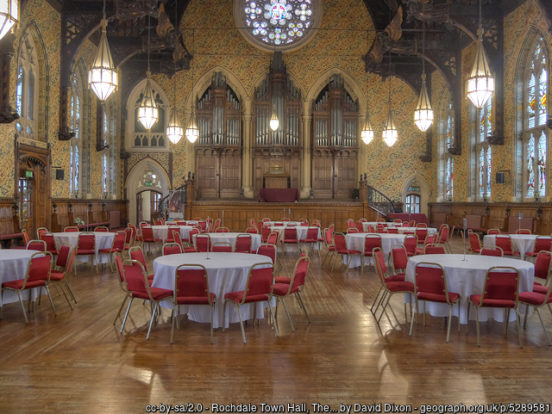
Oldham lies at the edge of the Pennines on elevated ground between the rivers Irk and Medlock. Oldham rose to prominence during the 19th century as an international centre of textile manufacture. Today Oldham is a predominantly residential town, and a centre for further education and the performing arts. Oldham Coliseum Theatre celebrated its centenary in 1987 and has seen performers such as Eric Sykes, Charlie Chaplin, Dame Thora Hird and Dora Bryan tread its boards.
Chadderton, a mile west of Oldham, was transformed in the 19th century from a rural township into a major mill town. Although Chadderton’s industries declined in the 20th century, the town continued to grow as a result of suburbanisation and urban renewal. The legacy of the town’s industrial past remains visible in its landscape of red-brick cotton mills, now used as warehouses or distribution centres.
The former mill town of Failsworth lies 3 miles south-west of Oldham. The poet and journalist Benjamin Brierley, noted for his poetry in Lancashire dialects and his sketches of Lancashire character, was born in the town in 1795 and is honoured by a bronze statue outside the library. Daisy Nook country park, centred on the disused Hollinwood Branch Canal, is named from Brierley’s A Summer Day in Daisy Nook (1859).
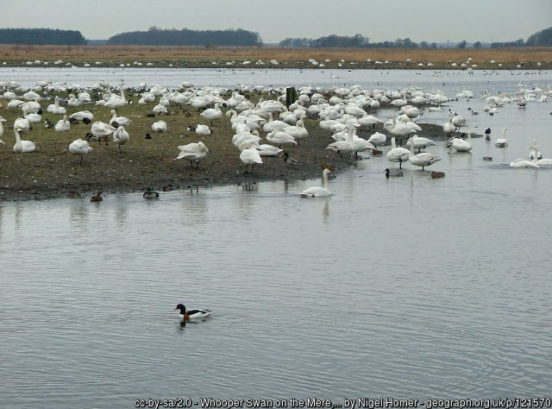
The West Lancashire Coastal Plain stretches south from the Ribble to the towns along the Mersey estuary. To the east the plain is bounded by the Lancashire Valleys and the former mining area around Skelmersdale, St Helens and Orrell. The coast is famed for its beaches, sand dunes and resort towns. The plain is very flat, much of it reclaimed from marshland and with a distinctive pattern of rectangular fields of dark peaty soil with deep drainage ditches. The Martin Mere nature reserve gives a glimpse of what this area was like prior to reclamation. The land is fertile and agriculturally very productive. The Leeds and Liverpool Canal crosses the plain. Ormskirk lies in the centre of the plain and traditionally is its main market town. Rufford Old Hall (NT), north of Ormskirk, has a Great Hall dating back to 1530 with period furniture, arms, armour, tapestries and a carved oak screen. The hall lies in splendid Victorian and Edwardian gardens.

Southport’s origins lie in 1792 when William Sutton set up a bathing house and then the South Port Hotel on the virtually uninhabited dunes at South Hawes, close to the newly constructed Leeds and Liverpool Canal. The canal brought visitors from Manchester, Bolton and Liverpool and by 1820 Southport had more than 20,000 visitors per year. Southport Pier, opened in 1860, has been called the first true “pleasure pier”. Southport remains one of the most popular seaside resorts in the United Kingdom. Formby is a commuter town, but also a popular tourist destination, with day trippers attracted to its beaches, sand dunes and wildlife, particularly the endangered red squirrel and natterjack toad.
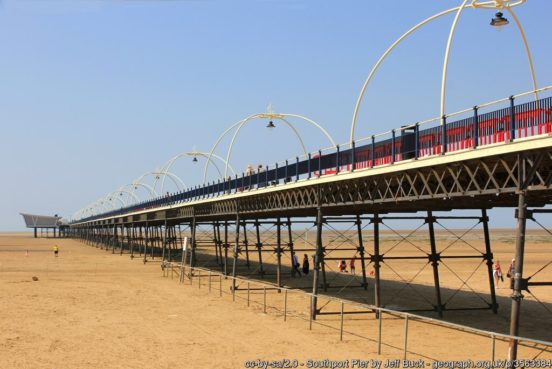
Crosby as an area has been drawn together out of a string of settlements. Along the shore are Blundellsands, Brighton-le-Sands and Waterloo. Inland are Great Crosby, Thornton and Little Crosby. Sir Antony Gormley’s sculpture Another Place, at Crosby Beach, consists of 100 cast iron figures, modelled on the artist’s own naked body, facing the sea.

Seaforth, to the south of Crosby, has the largest working docks on the Mersey. To its north is Liverland and east of that is Aintree, famous as the site of Aintree Racecourse, which since the 19th century has staged the Grand National. Bootle’s location on the Mersey north of Liverpool saw it grow as a dormitory town for wealthy merchants, and then as a centre of commerce and industry.
The city of Liverpool has a maritime, industrial, architectural and cultural heritage unlike any other. Founded by King John in 1207, Liverpool is built across a ridge of sandstone hills rising up to a height of around 230 feet above sea-level at Everton Hill, which represents the southern boundary of the West Lancashire Coastal Plain. Its growth as a major port was paralleled by the expansion of the city throughout the Industrial Revolution. Its status as a port city attracted a diverse population from a wide range of cultures, primarily Ireland, Norway and Wales. It is also home to the oldest black and Chinese communities in the UK. The city is closely associated with the arts, especially music; the popularity of the Beatles has contributed to the city’s status as a major tourist destination. Liverpool has a long-standing reputation as the origin of numerous actors and actresses, artists, athletes, comedians, journalists, novelists, and poets. The city is known for being the home of football clubs Liverpool and Everton.
Liverpool’s docks have been central to its development. The best known is the Albert Dock, which was constructed in 1846 and today comprises the largest single collection of Grade I listed buildings anywhere in Britain. One of the most famous locations in Liverpool is the Pier Head, renowned for the trio of buildings – the Royal Liver Building, the Cunard Building and the Port of Liverpool Building – collectively known as The Three Graces. The commercial district around Castle Street has many fine building including the Bank of England Building (1848), the Oriel Chambers (1864) and Liverpool Town Hall (1754), the city’s finest piece of Georgian architecture. William Brown Street, sometimes referred to as the “Cultural Quarter”, is also remarkable for its concentration of public buildings including the Walker Art Gallery (1877), Lime Street Station (1836) and St George’s Hall (1854), widely regarded as the finest neo-classical building in Europe.
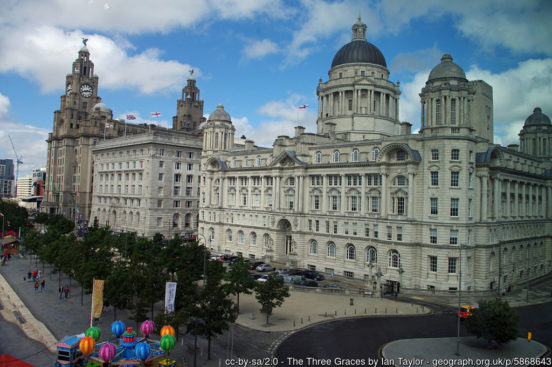
Liverpool Cathedral, built on St James’s Mount, is the largest cathedral and religious building in Britain. The cathedral is based on a design by Giles Gilbert Scott and was constructed between 1904 and 1978. Its tower alone soars more than 331 feet, its bells have the highest and heaviest peal in the world and it contains the largest operational organ in the world. Its internal spaces, awe-inspiring in their vastness, stun even the most jaded visitor into silent amazement. The Roman Catholic Metropolitan Cathedral of Liverpool, designed by Sir Frederick Gibberd and built from 1962-1967, lies half a mile to the north.
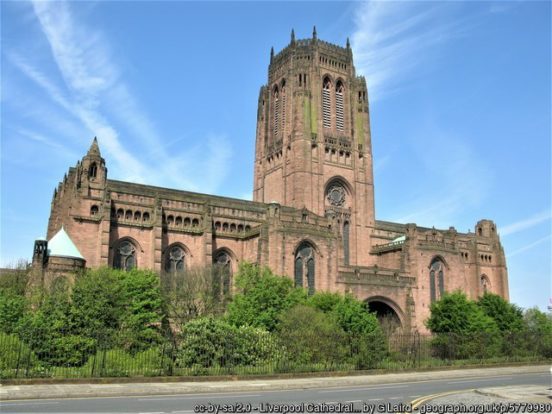
Liverpool has grown to include many former villages and small towns including Wavertree, Walton on the Hill, Garston, Gateacre, Woolton, Halewood, Childwall, Fazakerley and West Derby. Knotty Ash was made famous by its most famous son, the comedian Ken Dodd.
On the bank of the Mersey, south of Liverpool, is Speke Hall (NT), one of the finest wattle-and-daub Tudor manor houses in the country. It has splendid 19th-century gardens with views over the Mersey. At the south southern tip of the Mersey estuary is the village of Hale. John Middleton (1578-1623), known as the Childe of Hale, was reputed to be nine foot three inches tall. His cottage and grave are located in the village, as is a life-size carving. Hale Head is the southernmost point in Lancashire.

North of Hale, the Mersey estuary narrows to form the Runcorn Gap. On the Lancashire bank is Widnes, a centre of the chemical industry since John Hutchinson established his first chemical factory at Spike Island in 1848. Above Widnes the Mersey narrows into the Mersey Valley.
East of the West Lancashire Coastal Plain and north of the Mersey Valley, around the towns of St Helens and Wigan, is the heart of the South Lancashire Coalfield.
St Helens developed rapidly during the Industrial Revolution into a significant centre for coal mining, and glassmaking. The latter continues at Pilkington’s. The World of Glass narrates the making of St Helens into a world leader in glass making. The town of Huyton and the village of Roby lie south of St Helens, near the south-western extremity of the coalfield.

Between Huyton and St Helens is Prescot, formerly at the centre of the watch and clock making industry. From the mid-1590s to 1609, Prescot was home to the Prescot Playhouse, one of the few free-standing theatres in England outside London. It probably hosted performances by the playing companies maintained by the Earls of Derby. On the edge of the town is Knowsley Hall, ancestral home of the Earls of Derby, surrounded by 2,500 acres of parkland, which contains the Knowsley Safari Park.
Newton-le-Willows, east of St Helens, was the first “railway town”, developed as a centre for the transport of Lancashire coal. Ashton-in-Makerfield was a centre of lock and hinge manufacture, as well as coal mining. Neighbouring Haydock had 13 working collieries at its peak, all closed by 1971. More than 200 men and boys lost their lives in the Wood Pit disaster of 1878. Haydock Park racecourse lies between Haydock and the former mining and textile town of Golborne.
Wigan was incorporated as a borough in 1246. Its first mine was established in 1450 and there were 1,000 shafts within five miles of the town centre. Now there are none. George Orwell’s 1937 book The Road to Wigan Pier dealt with the living conditions of England’s working poor. The original “pier” was a coal loading staithe on the Leeds and Liverpool Canal, demolished before Orwell visited! The area’s collection of warehouses and wharfs has become a local heritage centre and cultural quarter. The town of Orrell was also a major mining town, though today it is a residential suburb of Wigan. Skelmersdale, west of Wigan, was an important colliery town. Skelmersdale was designated as a New Town in 1961 and has been developed from a mining village to a modernist town. Hindley grew to become a major coal mining and cotton town. It is now mainly a commuter town.
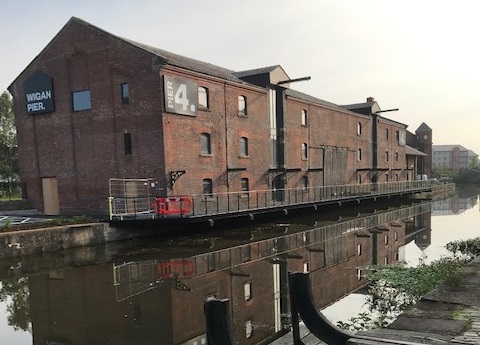
The Hulton Park Estate, east of Westhoughton, was the seat of the Hulton family for 700 years until the late 1990s. From the 1550s, the family grew wealthy from the rich coal seams under their estate. On 21 December 1910 an underground explosion at the Pretoria Pit claimed the lives of 344 men and boys. Memorials on the edge of Park and in Westhoughton cemetery mark their lives. During the 20th century the estate declined and Hulton Hall was demolished in the 1950s. To the east of the park is Over Hulton, a residential suburb. The former mining and nail manufacturing town of Atherton lies south of the Hulton estate. Today it is a major retailing centre. The suburb of Howe Bridge was built as a model pit village by the owners of Atherton Collieries.
Leigh, to the south of Atherton, had a considerable silk and cotton industry. The legacy of Leigh’s industrial past can be seen in the remaining red brick mills although it is now a mainly residential town. Tyldesley lies north of the vast Chat Moss which stretches south to the Mersey. The remains of a Roman road passing through the township on its ancient course between Coccium (Wigan) and Mamucium (Manchester) were evident during the 19th century. To the east are Little Hulton and Walkden, former mining areas become suburbs.
Worsley had been the site of coal mining since 1376. The Bridgewater Canal was commissioned by Francis Egerton, 3rd Duke of Bridgewater, to transport coal from his mines in Worsley to Manchester. The canal is regarded as an engineering masterpiece of the 18th century. James Brindley, a brilliant, self-taught mechanic and engineer, persuaded the duke to allow him to construct a gravity-flow canal crossing the Irwell valley on a viaduct carried on arches. The highly successful canal, completed in 1761, extended deep into the coalfield. Eventually 47 miles of subterranean tunnels were constructed with specially designed boats being loaded at the coal face to take transport their cargo to Manchester. The tunnels stretched as far as the (now former) mining towns of Farnworth and Kearsley to the north of Walkden. Worsley Delph, now a scheduled monument, was the entrance to the Duke’s underground mines. At the height of the operation a million tons of coal a year passed through it.
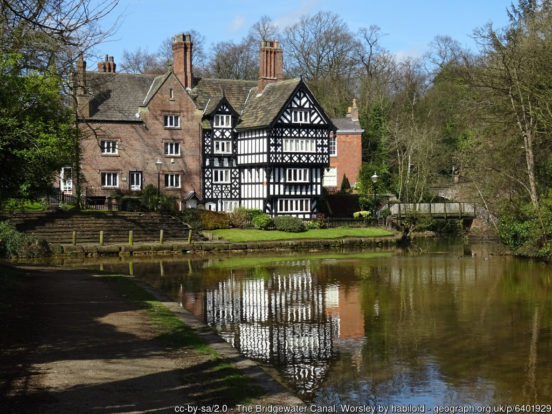
Worsley expanded following the completion of the canal to an important town based upon cotton manufacture, iron-working, brick-making and extensive coal mining. Worsley is now in the main a tourist destination and commuter town. The village, around Worlsey Green, has over 40 listed buildings. Wardley Hall is an early mediæval manor house, now the official residence of the Roman Catholic bishops of Salford. The skull of St Ambrose Barlow, one of the Forty Martyrs of England and Wales, is preserved in a niche at the top of the main staircase. According to legend, it is a screaming skull. As the canal passes through Worsley, iron oxide from the mines stains the water orange. RHS Garden Bridgewater is a public display garden of the Royal Horticultural Society. It lies in the grounds of the former Worsley New Hall estate, with the Bridgewater Canal forming the southern boundary.

To the east of Worsley lie the former mining towns of Swinton and Pendlebury. Swinton became an important industrial area with coal providing the fuel for the cotton spinning and brickmaking industries. Pendlebury saw extensive coal extraction until the closure of Agecroft Colliery in the 1990s. Agecroft Hall, the Tudor home of the Lord of the Manor of Pendlebury, stood on rising ground on the west side of the River Irwell. The house fell into disrepair and was sold in 1925 to Mr and Mrs Thomas C Williams who dismantled it and re-erected it as a tourist attraction on the banks of the James River in Virginia, USA.
South of Swinton at Irlams o’ th’ Height is the eastern end of the East Lancs Road (A580), the United Kingdom’s first purpose-built inter-city highway. The road was officially opened by King George V on 18 July 1934. The road was built to provide better access between the Port of Liverpool and the industrial areas of East Lancashire. Many of the original 1930s steel bridges remain.
The River Mersey forms the border with Cheshire for all of its length from where it is formed by the confluence of the rivers Tame and Goyt near Heaton Norris. Along its valley stand many of the county’s most famous towns and cities.
Warrington, 16 miles east of Liverpool, has been a major crossing point on the Mersey since ancient times. In mediæval times Warrington’s importance was as a market town and bridging point of the River Mersey. The expansion and urbanisation of Warrington largely coincided with the Industrial Revolution, particularly after the Mersey was made navigable in the 18th Century. Warrington was designated a new town in 1968 and consequently the town grew with many former villages becoming urban districts in the town, e.g. Great Sankey, Penketh, Bewsey, Hulme, Dallan, Orford, Padgate, Fernhead, Woolston and Martinscroft. Warrington Town Hall, dating from 1750, was described by Pevsner as “the finest house of its date in south Lancashire”. Bewsey Old Hall is a brick built, three storey, mainly Jacobean building, incorporating or reusing elements of a former mediæval hall.

The Manchester Ship Canal (completed 1893) runs from Ellesmere Port in Cheshire for 36 miles to just north of Salford Quays. It first crosses into Lancashire just east of Warrington where the (straightened) Mersey and the canal become one for a stretch past the villages of Hollins Green and Cadishead. Just south of the village of Irlam, the Mersey resumes its original course and the canal continues up a straightened version of the River Irwell between Salford and Manchester.
The town of Urmston lies between the Irwell/Manchester Ship Canal and the Mersey just east of their confluence. The town has early mediæval origins, and until the arrival of the railway in 1873 was a small farming community. The railway transformed the town into a residence for the middle classes. The former villages of Flixton and Davyhulme are now considered part of the town.
The town of Stretford spreads out on the plain between the Mersey and the Irwell/Manchester Ship Canal. The Bridgewater Canal bisects the town. During much of the 19th century Stretford was an agricultural village and an extensive market gardening area. The arrival of the Manchester Ship Canal in 1894, and the development of the Trafford Park, accelerated its growth.

North of Stretford, between the Bridgewater Canal and the Irwell/Manchester Ship Canal is Trafford Park. Until the late 19th century, it was the ancestral home of the de Trafford family who sold it to financier Ernest Terah Hooley in 1896. He formed the Trafford Park Estates Ltd company which oversaw its development as the first planned industrial estate in the world. The Imperial War Museum North lies within the park, alongside the canal. The huge retail park, the Trafford Centre, lies at its south-east end, by the village of Dumplington. Here the famous Barton Swing Aqueduct carries the Bridgewater Canal over the Manchester Ship Canal to Barton upon Irwell. The aqueduct is the first and only swing aqueduct in the world and considered a major feat of Victorian civil engineering. The swing bridge opened in 1894 and remains in regular use.

Old Trafford lies at the east end of Trafford Park at an ancient crossing point across the Irwell. The name derives from Old Trafford Hall, demolished in 1939, the de Trafford family residence until moving to the later hall in Trafford Park. In the 1820s, Manchester scientist John Dalton chose Old Trafford as the site for the Royal Horticultural and Botanical Gardens. The gateway of the Botanic Gardens still stands at the edge of the White City retail park, which now occupies the site. Old Trafford expanded to become an urban area as Trafford Park developed. Old Trafford has been the home of Lancashire County Cricket Club since 1864 and of Manchester United Football Club since 1910.
To the east of Stretford is Chorlton-cum-Hardy, a small town which has long since become a southern suburb of Manchester, as has the village of Withington to its east. Didsbury was a village just north of the Mersey which developed as a prosperous settlement during the Victorian expansion of Manchester and is now an affluent suburb. The Plumage League, which developed into the Royal Society for the Protection of Birds, was founded in 1889 by Emily Williamson at her home in what is now the Fletcher Moss Botanical Garden.

On the north bank of the Manchester Ship Canal/River Irwell, opposite to Trafford Park, is the former industrial town of Eccles. Eccles grew around the 13th-century Parish Church of St Mary. The area was predominantly agricultural until the Industrial Revolution, when a textile industry was established in the town. Eccles cake was first made here and is named after the town.
To the east of Eccles lies the city of Salford. The original settlement of Salford lies in a meander of the River Irwell, which river divides it from the centre of Manchester to the east. Salford began to emerge as a small town early in the 13th century. The oldest part of town in based around Chapel Road, Gravel Lane and Greengate, though the Sacred Trinity Church, dating from 1635, is the only survival from the pre-industrial era. The name comes from a ford in the River Irwell between Salford and Manchester. From the 14th century this site was spanned by what became known as Salford Old Bridge. This was replaced by the stone-arched Victoria Bridge in 1839. The stone-arched Blackfriars Bridge had been completed just down river in 1820.
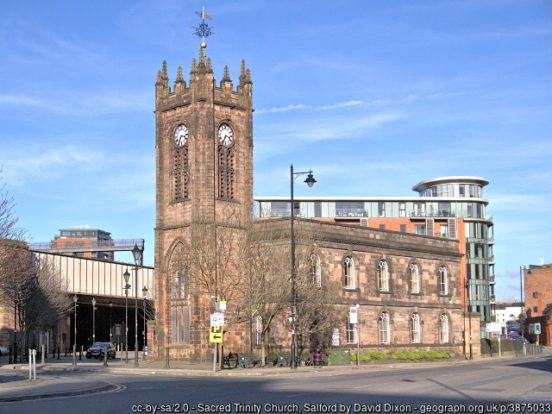
Salford became a major cotton and silk spinning and weaving factory town in the 18th and 19th centuries. The town expanded southwards alongside the Irwell to Ordsall. Ordsall Hall is a formerly moated Tudor mansion, the oldest parts of which were built during the 13th century. With the opening of the Manchester Ship Canal the town reached to Salford Docks, the principal docks of the canal. The docks closed in 1982 and were rebranded for the Salford Quays regeneration project. The Lowry centre, a theatre and gallery complex, is dedicated to L.S. Lowry, from nearby Pendlebury, famous for painting scenes of life in the industrial districts of the area in the mid-20th century. MediaCityUK has become a major centre for the BBC.
Across the River Irwell from Salford is the great city of Manchester. The recorded history of Manchester began with the civilian settlement associated with the Roman fort of Mamucium or Mancunium, which was established in about AD 79 on a sandstone bluff near the confluence of the rivers Medlock and Irwell. In the Anglo-Saxon period Manchester was apparently a fortified town; the Mercian army is recorded as having taken Mameceaster on Norþhymbrum from the Norsemen in 919. Manchester became a town of national and indeed world significance in the Victorian period, as the heart of the manufacturing revolution. During its growth it has encompassed several villages and towns including Hulme, Burnage, Levenshulme, Longsight, Gorton, Openshaw, Moston and Blackley.

Manchester today is a centre of the arts, the media, higher education and commerce. A reconstruction of the Roman fort from which Manchester got its name can be seen in the Castlefield conservation area. This area was also the terminus of the Bridgewater Canal, the world’s first industrial canal, built in 1764. The world’s oldest canal warehouse opened in 1779. The world’s first passenger railway terminated here in 1830, at Liverpool Road Railway Station, and the first railway warehouse opened here in 1831. Manchester Town Hall, built in the Gothic revival style, is considered one of the most important Victorian buildings in England. Heaton Park, in the north of the city, is a public park of over 600 acres around the neoclassical 18th-century country house, Heaton Hall.

To the south of Manchester, south of Burnage and east of Disbury, lie Heaton Chapel, Heaton Mersey, Heaton Moor and Heaton Norris, four villages which now form a suburban area known as the Four Heatons, though each with their own high street and identity. In the 19th century the Cheshire town of Stockport spread across the Mersey into Lancashire developing around Heaton Norris and Lancashire Hill. The Rivers Tame and Goyt converge to form the Mersey at the bottom of Lancashire Hill. East from here the River Tame forms Lancashire’s border with Cheshire.
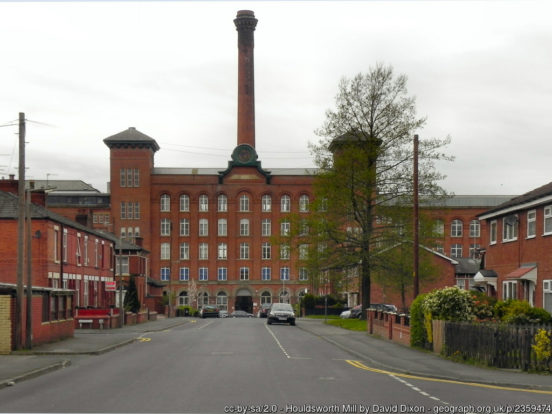
The town of Reddish stands north of the Tame. Reddish grew rapidly in the Industrial Revolution and still retains landmarks from that period, such as Houldsworth Mill. Further east is the town of Denton, famous as a former centre of the hatting industry. The Tame then flows north and alongside it lies Audenshaw with a heritage in hat-making, cotton-spinning, calico-printing, and silk-weaving. Nico Ditch, an early-mediæval linear earthwork possibly built as a defensive barrier against Vikings, runs through the area. Nearby Droylsden grew as a mill town on the Ashton and Peak Forest canals. The first machine woven towel in the world – the terry towel – was produced by W. M. Christy and Sons of Fairfield Mills, in Droylsden in 1851.
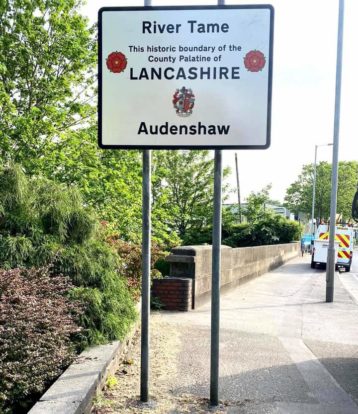
The market town of Ashton-under-Lyne stands on the north bank of the River Tame on undulating land at the foothills of the Pennines. The town is old: it was important enough to be granted a Royal Charter in 1414. However it only became a major centre at the Industrial Revolution. Although its traditional industries declined, the town has continued to thrive as a centre of commerce. Ashton Market is one of the largest outdoor markets in the United Kingdom.
To the east of Ashton, the town of Mossley lies across the Tame. Here Lancashire, Yorkshire and Cheshire meet. The Lancashire part, Mossley Brow, is west of the river and canal, with a natural centre at Market Street.
The Red Rose of Lancashire was first adopted as a heraldic badge by John of Gaunt, 1st Duke of Lancaster (1340-1399) and has come to symbolise the county. The county flag is formed from the red rose on a gold background, red and gold being the county’s livery colours.



One thought on “Lancashire Day – 27th November”
It’s surely time to reign in those revisionists in Furness who are obsessed with the ‘Cumbria’ dream. Barrow, Ulverston & co. crave Cumbria more than Lion wants meat! They are beyond redemption. Along with those in Westmorland that embraced Cumbria like a man possessed in April 1974 – look no further than historic Kendal that laughs at Westmorland (so sad…) and no one is worse than elderly people in fleece Regatta tops who have loved forgetting where they were born to latch onto Whitehall’s catch all fake non county of Cumbria!
Now Cumbria is to be split into 2 with the latest being a new Cumberland Council & similarly a new Westmorland & Furness Council expect (in fact it’s started in the local press) “We’re Cumbrians… we’re Cumbric… we wanted the ONE CUMBRIA option but the Government hasn’t passed it..”
Expect CUMBRIA to vigorously written on addresses more than it is even now (which will put holes in paper!).